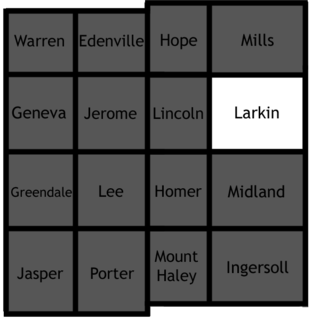
The Memphis & Arkansas Bridge, also known as the Memphis-Arkansas Bridge or Memphis-Arkansas Memorial Bridge, is a cantilevered through truss bridge carrying Interstate 55 across the Mississippi River between West Memphis, Arkansas and Memphis, Tennessee. Memphians refer to this bridge as the "Old Bridge" to distinguish it from the "New Bridge", or Hernando de Soto Bridge, upstream.

The Jackson Branch Bridge No. 15, also known as the Tecumseh Railroad Bridge due to its close proximity to the city of Tecumseh, is a historic railway deck truss bridge that spans the River Raisin in rural Raisin Charter Township in Lenawee County, Michigan. The bridge was added to the National Register of Historic Places on December 4, 2001.

The Waltz Road–Huron River Bridge is an automobile bridge located on Waltz Road spanning the Huron River in Huron Township, Michigan. It was listed on the National Register of Historic Places in 2000.

The Sheely Bridge, originally known as the Carbondale Bridge, carries pedestrian traffic across the Roaring Fork River at Mill Street Park in Aspen, Colorado, United States. It is a short steel truss bridge originally located downstream in Carbondale and later moved to its present location.

The Old US 41–Backwater Creek Bridge is a bridge located on an abandoned section of US Highway 41 (US 41) over Backwater Creek in Baraga Township, Michigan. It was listed on the National Register of Historic Places in 1999.

The Planter Road – Jackson Creek Bridge is a bridge located on Planter Road over Jackson Creek in Wakefield Township, Michigan. It was listed on the National Register of Historic Places in 1999.
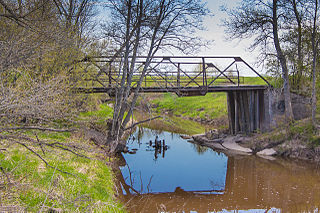
The Parker Road–Charlotte River Bridge, also known as the 10 Mile Road–Charlotte River Bridge, is a bridge building located on Parker Road over the Charlotte River in Bruce Township, Michigan. It was listed on the National Register of Historic Places in 2000.

The 23 Mile Road–Kalamazoo River Bridge is a curved-chord through-girder bridge in Marengo Township, Michigan, that carries 23 Mile Road over the Kalamazoo River. Built in 1922, it is listed on the National Register of Historic Places.

The Stony Creek Bridge is a bridge located on a private road over Stony Creek in Olive Township, Clinton County, Michigan. It was listed on the National Register of Historic Places in 1999. It is the last example of a queen post truss bridge extant in Michigan.

The M-88–Intermediate River Bridge is a bridge located on M-88 over the Intermediate River in Bellaire, Michigan. It was listed on the National Register of Historic Places in 1999. It is a noteworthy product of Depression-era relief work.
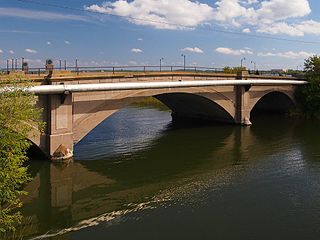
The Nymore Bridge is a reinforced concrete deck arch bridge spanning the Mississippi River in Bemidji, Minnesota. The bridge, built in 1916, has three arch spans. It is significant for its use of a reinforcing system patented by George M. Cheney during a time when engineers were experimenting with reinforcing materials and systems.
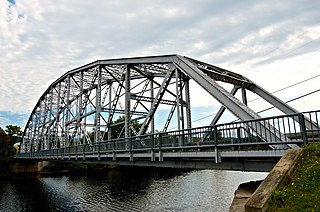
The Piermont Bridge carries New Hampshire Route 25 over the Connecticut River between Piermont, New Hampshire and Bradford, Vermont. It is a Pennsylvania steel through truss bridge, built by the Boston Bridge Works in 1928. The bridge consists of a single span with a clear span of 352' and an overall length of 354'10". The roadbed is 20'7" wide, with a vertical clearance of 14'7". The bridge is approximately 25' above the river. The western (Vermont) abutment is made of split granite quarried from nearby Fairlee Mountain, while the eastern abutment is an early concrete construction built in 1908 by John Storrs for an earlier bridge. The bridge underwent a major renovation in 1993 which included the addition of a sidewalk and replacement of much of the bridge decking.

The Crystal Springs Street–Dowagiac River Bridge is a road bridge that carries Crystal Springs Street over the Dowagiac River near Sumnerville, Michigan. It was installed in that location in 2017. Between 1938 and 2016, the bridge was located approximately 50 miles away, and carried M-86 over the Prairie River near Nottawa, Michigan, and was known then as the M-86–Prairie River Bridge. The bridge was listed on the National Register of Historic Places in 2000, and is the last remaining camelback pony truss bridge used on the state trunkline system in Michigan.

The Stancer Road–North Coldwater River Bridge is a road bridge carrying Stancer Road over the North Coldwater River in Union Township, Michigan. It was listed on the National Register of Historic Places in 1999. It is an excellent example of a pinned overhead Pratt truss bridge, which was once common in Michigan but is now quite rare.

The US-12–Coldwater River Bridge was a road bridge carrying Old US-12 over the Coldwater River in Coldwater, Michigan. It was listed on the National Register of Historic Places in 1999.

The Morseville Bridge is a bridge which formerly carryied Burt Road over the Flint River in Taymouth Township, Michigan. It was listed on the National Register of Historic Places in 1990. It is the oldest surviving highway bridge in Saginaw County.

The State Street Bridge, also known as the Fort Road Bridge or the Bridgeport Bridge, is a bridge carrying State Street over the Cass River in Bridgeport, Michigan. It was listed on the National Register of Historic Places in 1995.

The Gugel Bridge, also known as the Beyer Road – Cass River Bridge, is a bridge carrying Beyer Road over the Cass River in Frankenmuth Township, Michigan. It was listed on the National Register of Historic Places in 2000. It is the only remaining example in Michigan of a bridge with both a pony truss span and a main through truss span.

The Ball Road-Little Salt Creek Bridge, also known as simply the Ball Road Bridge, was a bridge carrying Ball Road over Little Salt Creek in Jasper Township, Michigan. It was listed on the National Register of Historic Places in 1999. The bridge was later demolished.
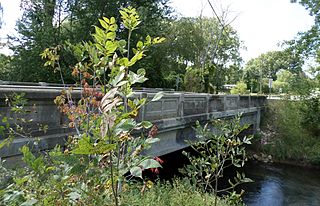
The M-50–Sandstone Creek Bridge, also known as th Tompkins Bridge, is a road bridge carrying M-50 over Sandstone Creek in Tompkins Township, Michigan. It was listed on the National Register of Historic Places in 2000.
